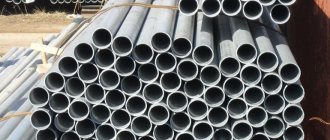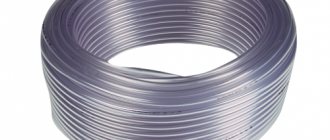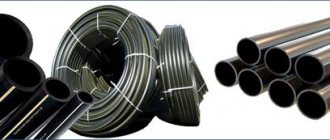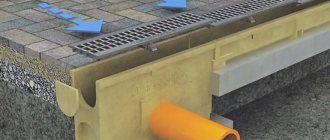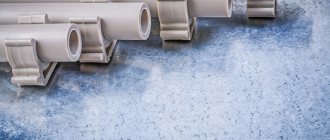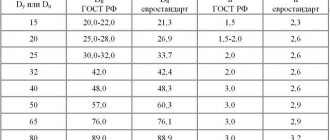Many of us have to deal with the need to replace water pipes. You can solve this issue yourself or with the help of a professional technician. When replacing a pipeline, it is important to understand what diameter of pipes for the water supply is optimal from a technical point of view. There is a wide variety of pipes on the market today, which vary in material quality, size and diameter. Our article will tell you what diameter products are suitable in this or that case.
Pipe dimensional characteristics
Modern water supply is a rather complex structure, the important element of which is pipes. The most popular are metal-plastic, steel and copper pipes. The main physical characteristics that determine the size of water supply pipes are:
- Inner diameter is a single characteristic for units and pipes of a water supply system. The internal diameter must be the same for both the pipes being connected and the fittings connecting them.
- Nominal diameter is a nominal value, measured in millimeters, used when installing water pipes.
- Wall thickness.
- Pipe length.
It is important to choose the correct diameter of plastic pipes for the water supply, otherwise you may encounter constant noise and problems in the water supply. This is due to flow turbulization, a process that occurs as a result of the use of small diameter pipes.
GOST requirements
According to GOST requirements, the internal and external walls of polyethylene pipes used in water supply systems must be smooth, without foreign inclusions, cracks, air bubbles, or cavities. Slight waviness or longitudinal stripes on the surface of the pipes are possible, but only if these defects do not affect the wall thickness and do not exceed the maximum permissible deviations. They are available in black or blue. Sometimes you can find black polyethylene pipes with three blue longitudinal stripes, which are distributed evenly around the circumference and represent markings. Gas pipes are distinguished from water pipes by yellow stripes on the same black background.
The purpose of the pipes can be determined by their appearance
Advice from a professional: Painting polyethylene pipes blue or black is necessary to quickly visually distinguish PE water pipes from products for other purposes.
Relationship between characteristics
How does the length of the water pipe affect the diameter of the pipes?
The average flow speed in a standard water supply is 0.02 km/s. This indicator affects the selection of pipe diameter. How to calculate the diameter of a water pipe taking into account the length of this communication:
- If the length of the system is less than 30 meters, you should pay attention to pipes with a diameter of 25mm.
- If the length of the system is more than 30 meters, the use of pipes with a diameter of 32 mm is considered relevant.
- If the length of the system is less than 10 meters, pipes with a diameter of 20 mm are perfect.
The standard length of domestic water supply pipes is 4 meters. But in practice, pipes up to 14-15 meters long can be used.
When choosing long products, special attention should be paid to the quality of fittings, couplings and other connections. They will ensure reliable and durable operation of the water supply system.
Why does the diameter of the pipes determine the throughput of the water supply system?
The diameter of the pipe determines an important characteristic - the throughput of the water supply system. For example, pipes with a diameter of 25 mm can move up to 30 liters of water within a minute. For a 32 mm pipe, this figure increases to 50 liters.
It should be borne in mind that an ordinary faucet in the kitchen or bathroom can flow no more than 5 liters of water. Thus, the choice of pipe diameter directly depends on the consumption of water resources.
The more points of water consumption, the larger the diameter of the pipes should be. Pipes for hot and cold water supply can be selected of the same diameter, but the wall thickness of pipes for hot water should be an order of magnitude higher.
When deciding what diameter of water supply pipe you need, pay close attention to the following parameters:
- The length of the water pipe.
- Number of proposed joints.
- Number of turns.
- Water pressure in the system.
Complex technical calculations used by professionals make it possible to calculate the complex influence of these factors on the plumbing system. However, their use is hardly advisable for premises in an apartment building.
Standard solutions
As a general rule, pipes with a diameter of 10 or 15 mm are selected for water supply, while the diameter of the pipes for the riser should be 25 mm. When purchasing pipes of the specified diameter, be prepared for the fact that these products do not have pinpoint accuracy. That is, a 10 mm pipe can actually have a diameter of 10-12 mm.
Complex plumbing work requires the use of pipes of increased diameter. They are optimal for operating a system with numerous joints, turns and permanent changes in water pressure.
To summarize: when choosing, pay attention to the following points:
- The more complex the design of the water supply system, the larger the diameter of the pipes.
- Hot water pipes require pipes with reinforced walls.
- The higher the water consumption rate, the larger the diameter of the pipes.
It is impossible to install a modern plumbing system without understanding the size of the pipes. The cross-section of such pipe products is of utmost importance.
Connection method
As already mentioned, polypropylene is joined by welding. But despite the high level of plasticity, the minimum bending radius does not allow making turns even at an angle of 90°, not to mention steeper ones. All branches and turns are made using fittings. These are special elements for connecting plastic pipes. This is a whole range of different parts for each diameter.
Fittings for polypropylene pipes: types and varieties
The difference is that the marking indicates the diameter of the pipe for which these elements are intended. So you don't need any sizing. If you are using a pipe, say, with a diameter of 25 mm, then simply take fittings with the same marking. It is better to buy both from the same company. Then there will be no problems. If you had to take products from different companies, try them on to be sure. Take a piece of pipe to the store and check compatibility. It should fit in without any problems, but tightly, without gaps.
Source
Characteristics of water pipes
When installing water supply networks, it is important to know the basic characteristics of pipe products. Materials of manufacture and diameters of water pipes are of great importance.
Material of manufacture
To decide which material is best to choose pipes from, you need to know the specifics of their use. Pipes for water supply are made from polypropylene and metal (steel, cast iron, copper).
The outer and inner diameters of plastic pipes for water supply differ from the same parameters of metal pipes. This is very important to take into account when making calculations.
This difference is an indicator of the thickness and strength of the pipe walls. And this directly affects the period of operation.
The advantages of steel pipes are strength and reliability. Their disadvantages include susceptibility to corrosion, heavy weight, and the formation of plaque on the walls.
Steel pipes of different diameters
The plastic analogue has more advantages, thanks to which it is more often chosen:
- light weight;
- does not corrode;
- simple and convenient installation;
- plastic;
- relatively inexpensive.
Polypropylene pipe (PN25) for water supply
However, there is a drawback here too. When the temperature changes, it undergoes linear expansion. A metal-plastic pipeline solves this problem. In addition, it is durable and reliable.
Therefore, it is very important to know all the above characteristics.
Water pipe length
The average flow speed is 0.02 km/s. Taking into account this indicator and the length of the water supply lines, you can select the diameter of the pipes:
- with a length of less than 10 m – 20 mm;
- for a length less than 30 m – 25 mm;
- for a length greater than 30 m – 32 mm.
For a riser, the diameter must be at least 20-25 mm. For a water pipe – 10-15 mm.
Diameter as the main parameter of the plumbing system
The main characteristic of water pipes is their size, which is their diameter.
Measured as an external and internal indicator. It is necessary to know the wall thickness, since this parameter is used to calculate the internal size.
It is important to remember that the correct choice of diameter will determine the throughput of the water supply and the quality of the supply of drinking water to the population.
When choosing the diameters of water pipes during the construction and repair of communication systems in a private house or high-rise, be sure to take into account the difference between the external and internal dimensions. If it is chosen incorrectly, plumbing fixtures may fail.
Diameter tables
When installing a pipeline made of dissimilar materials, some features should be taken into account.
For example, on products made of steel and cast iron, the outer diameter and wall thickness of the water pipe are indicated in mm.
If you need to connect pipes made of steel and plastic, special fittings are used. They are equipped with metal threads on one edge.
- Diameter table for steel water pipes
Steel pipe diameters GOST 854362989
- Size Chart for Copper Materials
Typical sizes of copper and steel pipes in inches and mm
A special feature of the marking of copper products is the indication of the external size in inches. Therefore, you need to know that 1" (inch) = 25.4 mm.
- Table of diameters of plastic pipes for water supply
Pipe diameters (PN10, PN16) for cold and hot water supply
On plastic pipes there is a designation of the outer size in inches and millimeters. It depends on the manufacturer.
Areas of application
Plastic pipes have a fairly wide range of applications. They are used not only for installing water supply systems, but also for other systems. We invite you to get acquainted with the main area of use of such products and their distinctive features.
Plastic pipes are presented in a wide range
Water pipes
The formed structure has a long service life. For its manufacture, various materials can be used, depending on the purpose and location of the work. For household purposes, mainly polyethylene and polypropylene are purchased. In collective industrial enterprises, products made from polyvinyl chloride are used. The features of the listed materials and the recommended area of use will be discussed below.
Polypropylene can be used for plumbing
Sewerage
For the installation of a sewer system, pipes made of PP, PVC, and PE can be used. Standardized sizes make it possible to use various plastic pipes for sewerage. The sizes and prices of such products are closely interrelated: the larger the transverse dimensions, the higher the throughput and cost.
The choice in favor of plastic pipes is made due to:
- resistance to aggressive environments;
- optimal strength characteristics. They are able to maintain their integrity at a meter depth;
- low roughness, reducing the likelihood of blockages and sediment on the inner surface;
- light weight;
- accessibility;
- easy installation.
Sewer pipes must be of the appropriate size
Plastic pipes for heating
The choice in favor of a plastic circuit for the heating system is made due to:
- reducing costs due to a lower degree of heating of the coolant;
- reducing the speed of movement along the heating circuit;
- simplifying installation work.
Before purchasing plastic pipes for heating, you should decide on the optimal diameter and type of system. The throughput of the system and the level of heat loss will depend on this. If the throughput is sufficient, it will be possible to abandon the branched system. When installing a heating circuit with forced circulation, plastic pipes with smaller transverse dimensions are selected: 8–10 mm. Systems with natural circulation will require products with a large cross-section.
For systems with forced circulation, the heating circuit has smaller transverse dimensions
How to calculate the diameter of a water pipe
Select the diameter using ready-made tables; they contain average data.
It is important to take into account that if the pipeline is long, there are many turns and joints on it. In this case, choose a larger diameter.
You can also use special formulas that will help you calculate the diameter of the water pipe as accurately as possible.
If you cannot calculate it yourself, you can contact specialists in this field. They will help you do it right.
Accurate selection of diameter is a procedure that requires attention and a serious approach.
The external dimensions of cylindrical pipe products are one of the main parameters indicated in the marking. The internal diameters of water pipes are determined by subtracting the wall thickness multiplied by two. The exception is materials made of steel and cast iron, which are marked by nominal size. This circumstance should be taken into account when installing systems made of different materials.
| Diameters of steel water pipes | ||
| Thread size (mm) | Internal section (mm) | Designation |
| 20.4 — 20.7 | 12.7 | 1/2″» |
| 22.4 — 22.7 | 15.9 | 5/8″» |
| 25.9 — 26.2 | 19.0 | 3/4″» |
| 29.9 — 30.0 | 22.2 | 7/8″» |
| 32.7 — 33.0 | 25.4 | 1″» |
| 45.8 — 46.2 | 38.1 | 1/5″» |
| 57.9 — 58.3 | 50.8 | 2″» |
The marking indicates the outer size and wall thickness. For example, with a diameter of 76x3 - a product with an outer section of 76 mm, a wall of 3 mm and an internal section of 70 mm. To connect steel materials to plastic, fittings are used, on one end of which there is a thread for steel, on the other there is a smooth coupling for soldering plastic. To select a connecting element, you need to focus on the thread size of the steel material.
Copper pipe products are marked by outer size, but in inches, which can also create difficulties during installation. In this case, it should be taken into account that in the marking 1″ is equal to 25.4 mm, that is, the numbers correspond to metric standards.
Standard diameters of plastic pipes
The dimensions of polyethylene pipe products are determined by GOST 18599-2001. The range is quite large - from 20 to 1200 mm. The most common: 63, 80 and 100 mm. for water supply PE 63 is a product that has short-term strength, but is not resistant to cracking and even destruction. Does not withstand pressure more than 6.3 MPa. At the moment it is almost not used due to its short service life.
PE 80 water supply pipe products are highly resistant to internal pressure. Made from low pressure polyethylene. Designed for transporting water with temperatures from 0 to 40°C. They are used to install water pipelines and sewage systems. They are supplied to the retail chain in black, with a longitudinal blue stripe, with a diameter of 16 to 110 mm. There are 9 types of these products, differing in operating pressure (from 0.32 MPa to 2.00 MPa).
Water pipe PE 100 is a pressure pipe, manufactured by extrusion and intended for installation of external water supply and pressure sewerage systems with temperatures from 0 to 40°C. They are supplied to the retail chain in coils and in lengths. The product is black with a diameter from 16 to 110 mm.
The marking of polyethylene materials contains the word “pipe”, grade of polyethylene, nominal diameter, wall thickness, “drinking” or “technical”, GOST designation.
Cross-linked polyethylene is designated as PEX-a, PEX-b, PEX-c, PEX-d.
Labeling of polypropylene products
The marking usually contains certification information, trademark or name of the manufacturer, name of the conformity standard (for example, 2458 ISO 4200/DIN), material designation, outer size and wall thickness, pressure rating (PN).
The outer size can be indicated in both the metric system and inches. It all depends on the manufacturer.
The table shows that the size designations do not correspond to the traditional metric system.
The diameter in the marking is indicated in the same way as on polypropylene. The material name can be PVC (PVC), CPVC (CPVC) or UPVC (plasticized PVC).
Marking of metal-plastic products
The marking of metal-plastic must contain the designation of the type of plastic, outer size, nominal pressure (PN), transported medium, batch number, year and date of manufacture and 13 digits containing information about the number of the shift, conveyor line, machine, etc.
If steel and a plastic water pipe are used to install the water pipeline, the diameters can be determined from the corresponding table. To connect sections of different materials, there are fittings that take into account all these features.
One way or another, we all had to deal with installing a plumbing system or replacing water pipes. If a person is not a professional in this field, it will be somewhat difficult for him to navigate the extensive offerings on the market, especially if he has to set up the system from scratch.
But regardless of whether you hire a professional or do the work with pipes yourself, it will be very useful to understand what the diameters of water pipes can be, as well as the difference between the diameters of steel and plastic water pipes.
Cross-linked polyethylene
With a further increase in pressure in the chamber, the molecules, which are long chains, begin to form cross-links with each other. This leads to the formation of a spatial structure in the form of a network, which leads to a significant increase in mechanical properties.
The result is a material that can withstand temperatures up to 95 degrees, which allows them to be used for hot water supply, while at the same time, a plastic pipe made of HDPE is resistant only up to 45 degrees, that is, it is only suitable for transporting cold liquid.
To further improve the mechanical properties, reinforced pipes are produced. Glass fiber threads are used as a reinforcing layer. Such pipes are already suitable for transporting liquefied gas under high pressure, or they are used in particularly critical areas.
The main regulatory document used in the production of polyethylene pipes is GOST 18599-2002.
Marking
The marking is applied to the outer surface and includes the following information:
- brand of polyethylene;
- the value of the dimensional ratio (ratio of Ø (dia.) to wall thickness – sdr);
- indication of nominal Ø (dia.);
- wall thickness;
- purposes for drinking or technical liquids;
- designation of the technical document used in production (GOST or TU).
General information about the diameters of water pipes
Water pipes made from different materials differ somewhat in size, in particular in the classification of measurement measures.
What determines the dimensions of water pipes:
- internal diameter
is the main conditional characteristic of both connecting nodes and water pipes; - Dу, diameter of the conditional transition
- this is the name of the nominal value of the internal diameter calculated in millimeters, its rounded value; - Dn – nominal diameter
; - outside diameter
; - wall thickness
etc.
In those days, when progress was carried out somewhere nearby, bypassing the countries of the post-Soviet space, the diameters of water pipes simply did not raise any unnecessary questions for the reason that there were no other diameters.
Diameters of pipes for water supply from various materials
Today's market may offer a slightly more diverse selection. For this reason, an amateur has a hard time trying to navigate and choose among plastic, metal-plastic and other diameters that meet his needs.
The choice is especially difficult when it is necessary to join pipes made of different materials when making repairs.
When installing water fittings, changing “inch” water pipes made of steel to pipes made of plastic, it is necessary to take into account that the names and designations for inches do not correspond to real metric sizes.
Systems for calculating the diameters of pipes made of various materials
When joining water pipes made of steel with pipes made of plastic, you can use standard transition elements - they are made taking into account the size of water pipes made of each material.
It may be somewhat more difficult if copper and aluminum pipes need to be replaced, since they are produced according to metric standards. In this case, the actual metric size of both the outer and inner diameters should be taken into account.
The size designations for water supply pipes are somewhat different from the generally accepted ones, and given that plumbers are quite inventive people, it is not surprising that they found an excellent way out of the situation. A special convenient thread system for the outer diameter was developed.
It can be described something like this. A half-inch pipe is produced with a diameter of less than 21 mm, the same diameter as the external thread. But when designating it, it is indicated in accordance with the internal diameter and the word “pipe” is added. In the documentation it looks like this: 1/2” pipes.
Diameters of steel water pipes
The internal diameter of pipes with different threads will be as follows:
- 1/2 inch pipe – 12.7 mm;
- 3/4 inch pipe - 19.0 mm;
- 7/8 inch pipe - 22.2 mm;
- inch pipe – 25.4 mm;
- 1.5 inch pipe – 38.1 mm;
- 2 inch pipe - 50.8 mm.
Pipe thread diameters:
- pipe 1/2 inch - 20.4 - 20.7 mm;
- pipe 3/4 inch - 25.9 - 26.2 mm;
- pipe 7/8 inch - 29.9 - 30.0 mm;
- inch pipe - 32.7 - 33.0 mm;
- 1.5 inch pipe - 45.8 - 46.2 mm;
- 2 inch pipe - 57.9 - 58.3 mm.
After familiarizing yourself with the sizes of water pipes, it is much easier to navigate the choice. To ensure that as few problems as possible arise when joining steel and plastic pipes, you can study special tables that show the dimensions of water pipes made of different materials.
Selecting the diameter of the water pipe
It is advisable to choose the diameter for the pipes in accordance with the water pressure in the system, the number of joints and turns, and the length of the water pipeline.
Of course, there are special calculation formulas that take into account the reduction in water pressure, which will depend on the number of joints, turns, as well as the length of the pipeline with the corresponding coefficients.
However, the practical use of such formulas for intra-apartment wiring is quite rare.
Usually they simply choose pipes for water supply - the diameter of which is:
- 15 millimeters (1/2 inch)
- 10 millimeters (3/8 inch).
When installing a riser, select pipes whose internal diameter is equal to:
- 25 millimeters (one inch);
- 20 millimeters (3/4 inch).
The diameter of the pipes is still a rather delicate issue. Given that the internal diameter of a half-inch plastic pipe ranges from 11 to 13 mm, and a one-inch one - from 21 to 23 (depending on the manufacturer), only plumber with extensive experience.
In case of complex wiring, multiple joints, turns and the need to lay pipes over a significant distance, when the pressure in the system for some reason is lower than the standard pressure, you should consider the possibility of installing pipes with a larger diameter.
Of course, it hardly makes sense to do the wiring in such a way that the diameter of the water pipes chosen for this purpose is larger than that of the riser. The larger the diameter chosen, the correspondingly better the pressure will be, but the situation is unlikely to be so serious that a highly accurate calculation of pipe diameters will be required.
Types and purpose
Polypropylene pipes can be single-layer or three-layer. Single-layer ones are used for water supply, sewerage, ventilation and other pipelines with the temperature of the transported medium not exceeding +45°C.
Three-layer PPR pipes are reinforced. Reinforcement is designed to reduce the amount of thermal expansion and nothing more. PPR pipes are reinforced with fiberglass and foil. Those with glass fiber are suitable for hot water supply, provided that the water temperature is not higher than 80°C. For heating and systems where water can heat up above 80°C, foil-reinforced polypropylene is used. The foiling may not be continuous. For such pipes, the permissible temperature of the transported medium is +95°C.
Can polypropylene pipes be used in underfloor heating systems? I guess, yes. The coolant temperature does not rise above +45°C, which is quite acceptable even for single-layer ones. But due to high thermal expansion, PPR pipes for heated floors are not the best option, even those reinforced with foil. There are more stable options and not more expensive.
Calculation of capacity for water pipes
Definition of throughput
Before you familiarize yourself with the rules by which the throughput of water pipes is calculated, it is necessary to study what the throughput is in general, and why it is necessary to find out this indicator.
Throughput is a metric characteristic, thanks to which it is possible to calculate and show the ratio of the maximum volume (in this case, liquid) passing through a pipe cross-section per unit of a certain period of time.
In addition to the usual ones, pipes made of metal-plastic or polymers have recently begun to be used in large quantities. It was then that the attitude towards the capacity of water supply pipes changed.
Unlike steel pipes, polymer pipes do not overgrow inside and are not subject to corrosion in the most inappropriate places, that is, the channels in such pipes are not in danger of becoming clogged inside with natural multi-layer deposits, and their throughput remains normal for a long time. With a steel pipe, the throughput capacity changes downward over time.
Properties of polypropylene
Although polypropylene is the least dense of all plastics, it is more resistant to abrasion, tolerates heat better, begins to soften only at 140°C, is chemically resistant, and almost does not crack as a result of corrosion. The material is plastic. Under loads not exceeding the maximum, it stretches and then returns to its previous shape without any changes in properties and characteristics. So it's a really good and safe option. Pipelines in food factories are made from polypropylene pipes.
An additional plus is that polypropylene pipes are easy to connect - they are welded. In general, not only water pipes and heating are made from polypropylene. This material can be used as a frame for greenhouses, country furniture and a bunch of other useful things.
As you can see, the diameters of polypropylene pipes are different. And that's not all. There is also up to 1600 mm
Polypropylene has two disadvantages: high thermal expansion and reaction to oxygen and ultraviolet radiation. We learned to deal with both. In order for polypropylene to tolerate UV rays and light, stabilizers are added. To reduce thermal expansion, reinforced pipes are made. But even with reinforcement, the increase remains large and compensators must be installed in pipelines.
Another disadvantage of polypropylene pipes is that they become brittle at low temperatures. Some types begin to crumble at -5°C, others at -15°C. So external pipelines made of polypropylene require UV protection and insulation. That's why they probably prefer to bury them.
